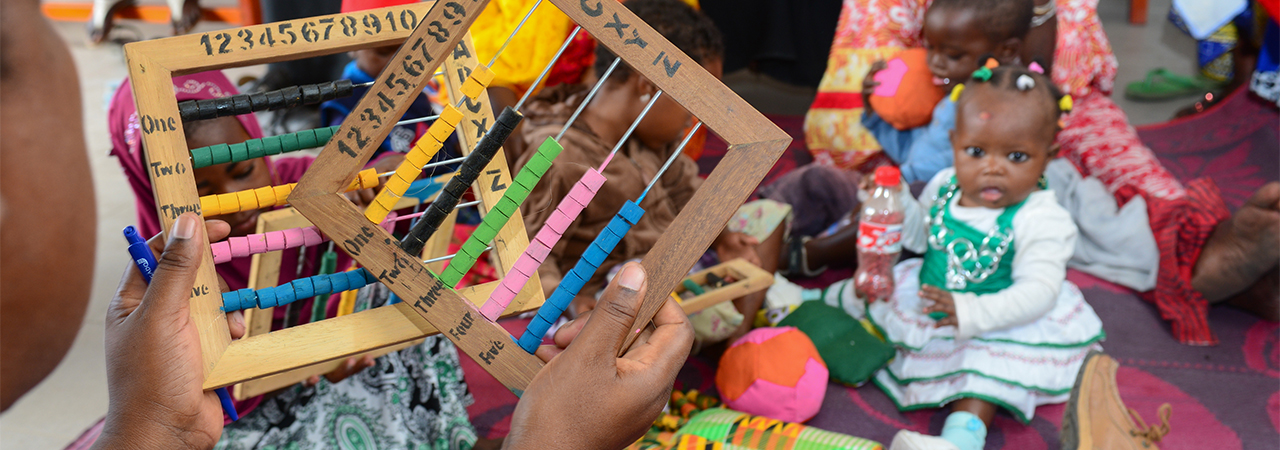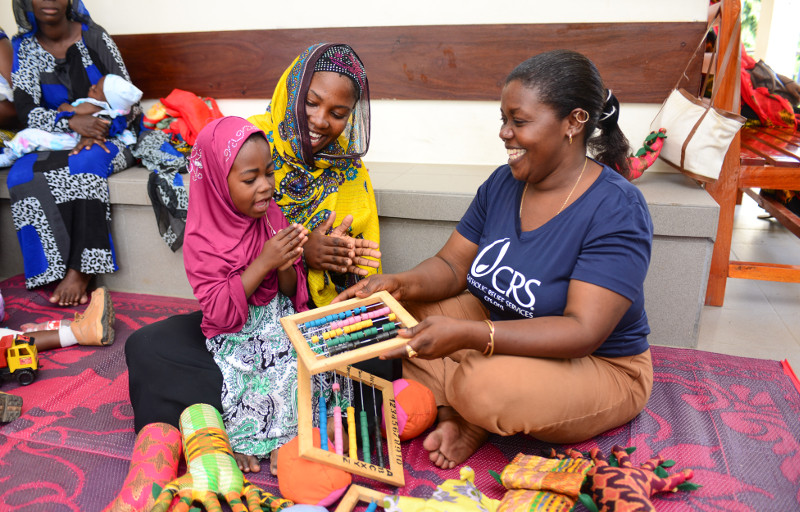

A New Toy Story: How Cans, Buttons & Boxes Build Brains
A new Toy Story is being told with tin cans, old socks, buttons, boxes and plastic bottles.
Savvy adults take stuff that might be regarded as junk and upcycle it to help raise smarter, healthier children. The toys are simple and require a lot of imagination—but that's the point.

An estimated one-third of children—some 200 million—under age 5 fail to meet their developmental potential. That's why early childhood development—a child's physical, cognitive, linguistic, social and emotional development from before birth to age 8—is a critical focus for CRS.
Toys can help by stimulating minds and engaging imaginations. In fact, toys are often a child's introduction to education, creativity and socializing.
Because toys fire brain activity that is vital to future learning and survival, getting toys into the hands of children at an early age can mean less need for help in the future. But toys can be taken for granted or simply dismissed as unnecessary. For families that need to focus their energy on securing food, shelter, medicine and clothing, toys may be seen as a luxury.
THRIVE promotes health spectrum
With support from the Conrad N. Hilton Foundation, the THRIVE project in Tanzania, Kenya and Malawi helps children across the 0-age 5 continuum receive high-quality services and support so they can reach their potential.
Many children are particularly vulnerable at this critical period because of poverty and HIV. THRIVE helps them get proper health care and nutrition for their bodies—and their minds. That's where the toys come in.
Toys as tools for learning
Research and common sense agree: play is essential to learning. It's central to early childhood development. And toys are the tools children use to play. They are necessary to develop and stimulate the brain.
Toys do not need to be expensive or come from a store. A kitchen pan lid or a homemade block can do just as much as the latest gadget from any high-end specialty toy store. Experience and research show toys just need to help children interact and explore the world around them.
From trash to building blocks for growth
Toys open up a world of possibilities for children and their parents.1 Besides helping children meet developmental milestones and acquire language skills, toys encourage imagination and social development. They can foster friendships, as children learn how to share, negotiate and challenge each other.

Toys can build a child's confidence. "See what I built?" a child says as he or she finishes stacking blocks, for example. Children are proud of what they can do with toys, and when an adult acknowledges that accomplishment, their self-esteem gets a boost.
Toys can provide income. Many parents and guardians have become enthusiastic toy makers. They are proud to share their work and can often sell the toys for a profit.
Child friendly spaces
Since September 2012, CRS has helped thousands of adults recognize the importance of toys and play in children's lives. First, CRS trains partners to help children develop gross and fine motor skills. Those partners then work with parents to enhance their children's learning.
Classroom work and home visits help parents understand that toys do more than distract children; they are important tools for identifying and developing the individual talents and interests of children.
An adult in Tanzania recalls observing a budding writer: "Every time she comes, she chooses the pen to use. After taking the pen, she tries to scribe. When you give her other stuff like a ball, she throws them away. She only likes the pen. Maybe she has the talent of studying and writing."
Communities and health facilities hold clinics and workshops for parents at least once a month in part to help them recognize these opportunities for children's growth and development. And while the parents participate in the workshops, their children have opportunities to play and socialize with other kids.
The workshops teach parents the importance of attachment through body and eye contact, positive feedback—like smiling—and the benefits of breastfeeding. They also learn how to make toys and encourage learning in the home.
"[At the training,] I learned how to make balls and footballs. When I got home, my grandkids were so impressed. Kids are so happy to see what we have, and they don't believe that we are the ones that made it," says a volunteer.
Teaching parents and kids
Many adults enthusiastically share what they have learned, and their enthusiasm is contagious. Thanks to their work—and that of other community members—children have dozens of unique toys to play with.
"This one parent used to say you should go and buy a ball for the child. But at the [early childhood development center], I showed him how to make a ball … the kid has lots of toys at home now," says a community health worker in Kenya. Now, more toys—many made with odds and ends from around the house—are reaching more kids.
"I was making stimulation tools by drawing a duck picture. Where I stay, it is just by a roadside. So many people were passing by. People have copied my skills. I once visited one family and I saw that same thing that I made," says a health worker from Tanzania.
Safety first
Besides the benefits of toys, caregivers also learn how to create a safe environment by ensuring toy-making materials don't have sharp parts and choking hazards. The toys they make are simple and age appropriate.
For newborns, a mobile using string and paper provides visual stimulation. Research shows that visually appealing objects stimulate babies' brain growth.
For infants, storytime with a handmade book provides bonding time. Books also help with early literacy, diction, pronunciation, language and vocabulary.
Toddlers respond well to singing and physical activities. Building with blocks and playing dress-up expand creativity.
3- to 5-year-olds, with their longer attention span, can handle number and letter cards. Other activities—like taking turns rolling a tire—help develop hand-eye coordination and encourage social skills.
CRS RESOURCES:
Take a look at toys made through CRS' THRIVE program in this photo gallery.
Explore a manual that teaches parents about early childhood development and how to become toy makers in their homes.
Read about our work supporting mothers and their mental health through THRIVE in Kenya, Malawi and Tanzania.
Check out other work CRS is doing to strengthen family relationships. We'll highlight some of these at the World Meeting of Families in Philadelphia in September.
ADDITIONAL RESOURCES:
National Association for the Education of Young Children: Play and Children's Learning
__________
1"Parent" in this story refers to anyone primarily responsible for the child's upbringing and doing the work of a parent.

